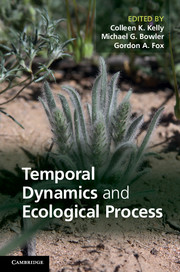Book contents
- Frontmatter
- Contents
- List of Contributors
- 1 Introduction
- Part I Observing temporal processes in nature
- 2 The storage effect: definition and tests in two plant communities
- 3 What temporal processes in trees tell us about competition, community structure and speciation
- 4 Testing the storage effect with long-term observational data
- 5 Seedling herbivory and the temporal niche
- 6 Temporal variation in density dependence in an herbaceous community
- 7 Population and community dynamics in variable environments: the desert annual system
- 8 Temporal niches, ecosystem function and climate change
- Part II Application to specific questions
- Index
- References
5 - Seedling herbivory and the temporal niche
Published online by Cambridge University Press: 18 December 2013
- Frontmatter
- Contents
- List of Contributors
- 1 Introduction
- Part I Observing temporal processes in nature
- 2 The storage effect: definition and tests in two plant communities
- 3 What temporal processes in trees tell us about competition, community structure and speciation
- 4 Testing the storage effect with long-term observational data
- 5 Seedling herbivory and the temporal niche
- 6 Temporal variation in density dependence in an herbaceous community
- 7 Population and community dynamics in variable environments: the desert annual system
- 8 Temporal niches, ecosystem function and climate change
- Part II Application to specific questions
- Index
- References
Summary
Seedlings and the temporal niche
The facilitation of plant coexistence via temporal variation in plant recruitment is increasingly studied (see this volume plus Pake and Venable 1996, Chesson and Huntly 1997, Kelly and Bowler 2002, Verhulst et al. 2008). For the most part however, corroborating studies have examined fluctuations in abiotic factors and the role of biotic agents has been largely overlooked. This omission is symptomatic of the plant coexistence literature in general; the role of predators, herbivores, pathogens and parasites in maintaining species coexistence is more often assumed than demonstrated (but see Kelly and Bowler 2009a). Nonetheless, while a number of agents, biotic and abiotic, result in the death of entire seedling cohorts, foremost among the factors limiting seedling recruitment is herbivory (Moles and Westoby 2004, Fenner and Thompson 2005). Herbivore attack has obvious effects on seedling demography (Lindquist and Carroll 2004, Maron and Crone 2006, Maron and Kauffman 2006), but even beyond population-level considerations, selective seedling removal also exerts long-lasting effects on plant community composition. We propose that temporal fluctuation in herbivore populations, and consequently variation in the intensity of herbivory experienced by plants during their regeneration phase, exerts a powerful influence over plant species contribution to the established community.
There are four necessary conditions of any temporal dynamic involving herbivory. First, seedling herbivores must be capable of moderating plant community composition in established vegetation. Second, herbivores should select preferred seedlings on the basis of readily apparent ecophysiological characteristics. Third, and related to the previous assumption, any variation in seedling susceptibility to herbivore attack (i.e. defensive traits) will most probably correlate with competitive ability. Finally, herbivore populations must show fluctuations in numbers and therefore variation in their influence on regenerating plants. Consequently, before it is possible to develop any conceptual framework to explain how temporal variation in seedling herbivory influences species coexistence, we must first evaluate the evidence for these conditions.
- Type
- Chapter
- Information
- Temporal Dynamics and Ecological Process , pp. 102 - 122Publisher: Cambridge University PressPrint publication year: 2014
References
- 4
- Cited by

